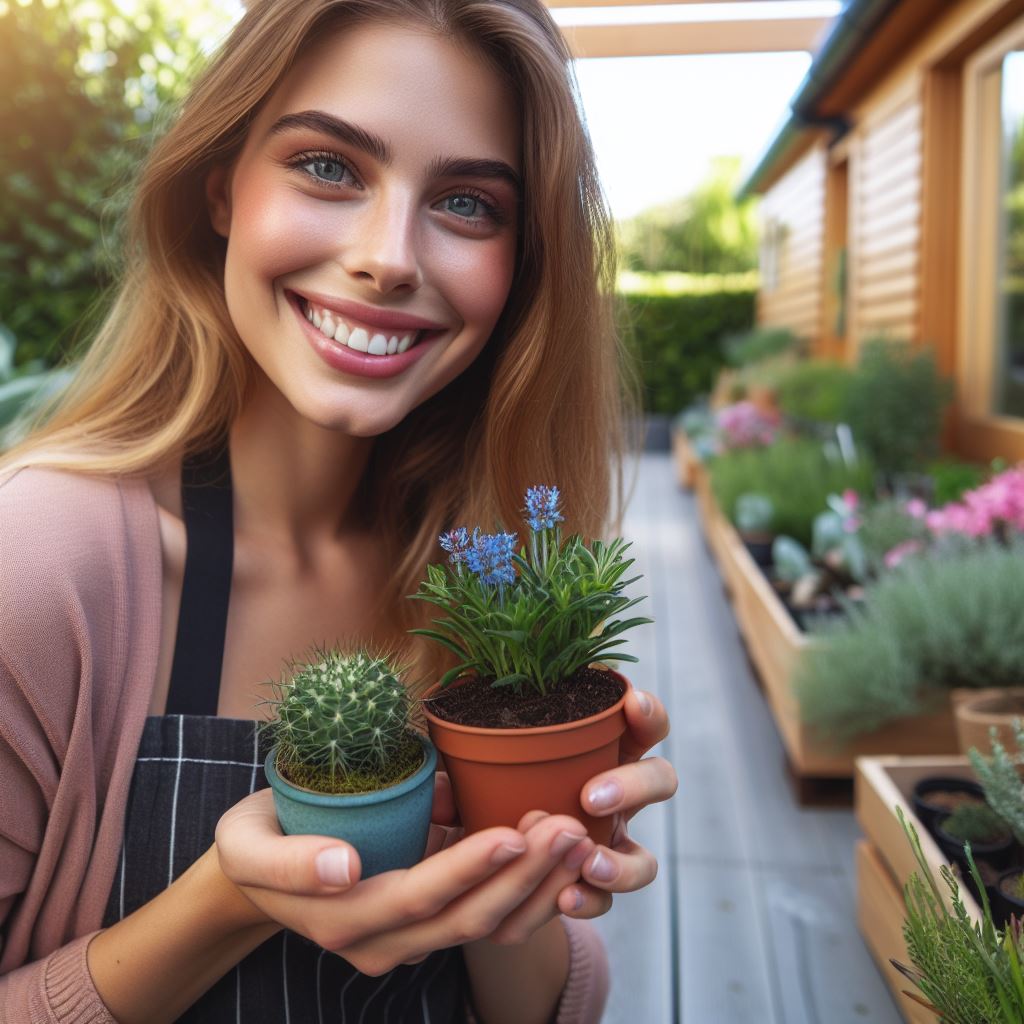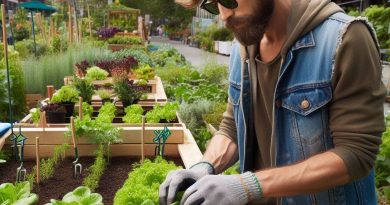Easy Composting for Beginners: A Step-by-Step Guide
Last Updated on March 2, 2024
Introduction
A. Importance of Composting for Gardening and Sustainable Living
- Composting is vital for enriching soil, promoting healthy plant growth, and reducing waste.
- By composting, you recycle organic materials into nutrient-rich soil amendments.
- It’s an eco-friendly practice that minimizes landfill waste and reduces greenhouse gas emissions.
- Composting fosters biodiversity in soil, supporting diverse ecosystems and resilient plant life.
- It’s a cornerstone of sustainable living, aligning with principles of conservation and environmental stewardship.
B. Benefits of Composting for Beginners
- Easy composting is accessible to beginners, requiring minimal equipment and effort.
- It’s cost-effective, saving money on commercial fertilizers and soil conditioners.
- Composting reduces reliance on synthetic chemicals, fostering organic and natural gardening practices.
- Beginners can learn about decomposition, nutrient cycles, and the interconnectedness of ecosystems.
- It’s a rewarding journey, witnessing firsthand the transformation of waste into valuable organic matter.
- Composting fosters a sense of accomplishment and connection to nature, promoting overall well-being.
- For beginners, composting offers an entry point into sustainable living practices, empowering individuals to make a positive environmental impact.
In this section, we’ll delve deeper into the world of easy composting, exploring simple techniques, troubleshooting common challenges, and reaping the rewards of sustainable gardening. Let’s embark on this enriching journey together!
Choosing the Right Composting Method
Composting is an excellent way to recycle organic waste and create nutrient-rich soil for your garden.
However, before you start, it’s important to choose the right composting method that suits your needs and lifestyle.
Here, we’ll discuss different composting methods and factors to consider when selecting a method.
A. Different composting methods
- Backyard composting: This is the most traditional method that involves creating a compost pile in your backyard.
- Vermicomposting: Vermicomposting uses red worms to break down organic materials into nutrient-rich compost.
- Trench composting: In trench composting, you dig a trench and bury your organic waste directly into the soil.
B. factors to consider when selecting a method
Each method has its own advantages and considerations, so let’s take a closer look at the factors to consider when selecting a composting method:
- Available space: Assess the availability of space in your backyard or garden. Backyard composting requires enough space for a compost pile or bin, while vermicomposting can be done indoors using specialized containers.
- Time commitment: Consider the time you can dedicate to managing your compost pile. Backyard composting and vermicomposting require regular monitoring and turning of the compost, while trench composting is relatively low maintenance once the trench is established.
- Desired outcome: Think about what you want to achieve with your compost. Backyard composting and vermicomposting produce compost that can be used as a soil amendment and fertilizer.
Trench composting, on the other hand, helps enrich the soil directly and promotes healthy plant growth. - Climate and weather conditions: Take into account your local climate and weather conditions. Backyard composting and vermicomposting can be done year-round, while trench composting may be affected by extreme temperatures or heavy rainfall.
- Types of organic waste: Consider the types of organic waste you generate and have available for composting.
Backyard composting and vermicomposting can handle a wide range of organic materials, including vegetable scraps, yard trimmings, and coffee grounds.
Trench composting is best suited for kitchen scraps and yard waste. - Odor and pest control: Evaluate your ability to manage potential odors and pests associated with composting.
Backyard composting and vermicomposting may require more attention to control odors and discourage unwanted pests, while trench composting is generally less prone to these issues.
Choosing the right composting method depends on space, time, outcome, climate, waste types, odor, and pest control.
Select wisely for a fulfilling composting experience and eco-friendly impact!
Read: Urban Farm Water-Saving: Top 5 Effective Methods
Setting Up a Composting System
A. Materials needed for composting
Once you have gathered all the necessary materials, you can start setting up your composting system.
Here’s how:
B. Choosing an appropriate composting location
It’s important to select the right spot for your compost pile or bin.
Consider the following:
- Find a sunny spot: Place your compost in an area that receives direct sunlight for a few hours each day. The heat helps speed up the decomposition process.
- Good drainage: Ensure that the location has good drainage to prevent water from accumulating and causing unpleasant odors.
C. Tips for creating a balanced composting mix
A balanced composting mix consists of both “green” waste (nitrogen-rich materials) and “brown” waste (carbon-rich materials).
Here’s how you can achieve that:
- Green waste: Include kitchen scraps like fruit and vegetable peels, coffee grounds, and tea bags. These materials provide nitrogen, which helps break down organic matter.
- Brown waste: Mix in yard waste such as leaves, twigs, and small branches. You can also add shredded newspaper, cardboard, or straw. Brown waste provides carbon, which helps create aeration and balance the nitrogen-rich materials.
Remember to maintain a proper ratio of green to brown waste, approximately 2:1 or 3:1 (carbon to nitrogen).
By following these steps, you can set up an effective composting system that will turn your organic waste into nutrient-rich compost for your garden.
Read: Fall Harvest Guide: Best Practices
Adding Compostable Materials
Composting is a fantastic way to reduce waste and create nutrient-rich soil for your garden.
In this step, we will explore the different types of materials that can be added to your compost pile.
Remember, it’s essential to use the right items to ensure proper decomposition and avoid any potential issues.
A. Common kitchen scraps suitable for composting
- Fruit and vegetable scraps: These include peels, cores, and any leftover bits from your meals.
- Coffee grounds: After brewing your morning cup of joe, save the coffee grounds for your compost pile.
- Eggshells: Crushed eggshells are an excellent source of calcium and can be added to your compost.
- Tea leaves and tea bags: After steeping your tea, remove the tea leaves or tea bags, and add them to your compost.
B. Types of yard waste that can be composted
- Grass clippings: After mowing your lawn, collect the grass clippings and add them to your compost pile.
- Fallen leaves: Rake up fallen leaves from your yard and use them as a carbon-rich brown material in your compost.
- Plant trimmings: When pruning your plants, save the trimmings and add them to your compost.
C. Ensuring to avoid composting certain materials
While there are many materials suitable for composting, some items should never be added to your pile.
These include:
- Meat: Avoid composting any meat, including bones and fat. It can attract pests and create unpleasant odors.
- Dairy products: These also attract pests and can lead to a smelly compost pile.
- Oily items: Greasy food scraps and oily materials should be avoided as they can hinder the decomposition process.
- Diseased plants: Refrain from adding plants that are diseased or infested with pests. This helps prevent spreading diseases in your compost.
It’s important to maintain a balance of green (nitrogen-rich) and brown (carbon-rich) materials in your compost pile.
Too much of either can slow down the decomposition process or create unpleasant smells.
Aim for a ratio of roughly 3 parts brown materials to 1 part green materials.
Remember to chop or shred larger items, such as branches or corn cobs, into smaller pieces.
This helps speed up the decomposition process and ensures a more uniform compost mix.
It’s also beneficial to moisten your compost pile periodically, as it needs to be slightly damp, like a wrung-out sponge.
By adding the right materials to your compost pile, you’re well on your way to creating nutrient-rich compost that will benefit your garden and reduce your environmental impact.
Happy composting!
Read: Winter Prep for Your Garden & Farm

Maintaining the Compost Pile
Once you have set up your compost pile, it is important to maintain it properly to ensure the decomposition process goes smoothly.
Here are some key tasks to consider:
A. Turning or aerating the compost
A crucial step in maintaining the compost pile is turning it regularly.
Turning the pile helps to aerate it, providing oxygen to the microorganisms responsible for breaking down the organic matter.
This increased airflow helps speed up the decomposition process.
Simply use a pitchfork or shovel to turn the pile, mixing the outer and inner layers, and bringing the bottom to the top.
Aim to turn the compost every one to two weeks.
B. Monitoring and adjusting moisture levels
The moisture level of your compost pile is essential for effective decomposition.
Ideally, the compost should be as moist as a well-wrung sponge.
If it becomes too wet, it can become compacted and lack oxygen.
If it becomes too dry, the decomposition process slows down.
Regularly check the moisture content by grabbing a handful of compost and squeezing it.
If it feels too dry, you can add water using a hose or spray bottle.
If it feels too wet, mix in dry, brown materials like leaves or shredded paper to absorb excess moisture.
C. Troubleshooting common issues
While composting is a natural process, sometimes issues can arise that require attention.
Here are some common problems you may encounter:
1. Odor
If your compost pile begins to emit an unpleasant odor, it could be a sign that the decomposition process is not happening efficiently.
This can be caused by an imbalance of green and brown materials or an overly wet compost pile.
To resolve this issue, add more brown materials like dried leaves or shredded paper to neutralize the odor.
Mix the pile thoroughly to ensure proper airflow, and adjust the moisture level if necessary.
2. Pests
Occasionally, pests like rodents or flies might be attracted to your compost pile.
This is often a result of including food scraps that should not be composted, such as meat or dairy products.
To deter pests, make sure to avoid adding these types of items to your compost pile.
Additionally, covering your compost with a layer of brown materials can help discourage pests from entering.
3. Slow decomposition
If you notice that your compost pile is taking longer than expected to decompose, it could be due to incorrect ratios of green to brown materials or a lack of moisture.
To speed up the process, make sure you have a balanced mix of green and brown materials.
Consider adding more nitrogen-rich greens if the pile is too brown and carbon-rich.
Also, remember to check the moisture level and adjust accordingly.
By following these maintenance steps, you can ensure that your compost pile remains healthy and productive throughout the decomposition process.
Remember, patience is key, and with time, you’ll be rewarded with nutrient-rich compost for your garden!
Read: Small Garden? Big Savings: Water Efficiency Tips
Explore Further: Hydroponic Basics for Urban Farmers
Harvesting and Using Compost
A. Signs that compost is ready for use
Once your compost has fully decomposed, it’s time to harvest and put it to good use.
Here are some signs that indicate your compost is ready for use:
- Dark, crumbly texture: The compost should have a rich, dark color and a crumbly consistency, resembling soil.
- Earthy smell: A well-composted pile will have a pleasant, earthy smell, indicating that the organic matter has broken down properly.
- Absence of recognizable materials: The compost should no longer contain any recognizable bits of food or yard waste.
B. Techniques for harvesting compost
To harvest the compost, you can use the following techniques:
- Sifting: Use a fine mesh screen or sieve to sift the compost and separate any larger chunks or unfinished materials.
This will result in a finer, more uniform texture. - Removing finished compost layers: If your composting system has different layers or compartments, you can remove the finished compost from the bottom while allowing the unfinished materials to continue decomposing.
C. Ways to utilize compost in the garden or potted plants
Now that you have harvested your compost, here are some ways you can utilize it in your garden or potted plants:
- Soil amendment: Mix the compost into your existing garden soil to improve its fertility and nutrient content. It will enhance the soil structure, retain moisture, and promote healthy plant growth.
- Mulching: Spread a layer of compost around the base of your plants to act as a natural mulch. This will help suppress weeds, conserve moisture, and regulate soil temperature.
- Seed starting mix: Blend compost with potting soil to create a nutrient-rich mix for starting seeds indoors. It provides young plants with essential nutrients for healthy development.
- Compost tea: Steep a handful of compost in a bucket of water for a few days, then strain and use the resulting liquid as a natural fertilizer. Dilute it with water before applying to your plants.
- Top dressing: Sprinkle a thin layer of compost around established plants to give them a nutrient boost. Be careful not to smother the plant stems or leaves.
- Container gardening: When planting in containers, mix compost with potting soil to create a nutrient-rich growing medium. It will help retain moisture and provide a steady supply of nutrients to your plants.
Remember to use compost in moderation, as too much can overwhelm certain plants and disrupt the balance of nutrients in the soil.
Start with small amounts and observe how your plants respond before increasing the quantity.
In general, harvesting and utilizing compost is a rewarding step in the composting process.
By following the signs of readiness and employing proper techniques, you can enhance your garden’s health and productivity while reducing organic waste.
Experiment with different applications to discover what works best for your plants and enjoy the benefits of nutrient-rich compost.
Conclusion
To recap, easy composting for beginners involves four simple steps:
choose a composting method, gather organic materials, create the compost pile, and maintain it by turning and watering regularly.
By following these steps, anyone can successfully create nutrient-rich compost for their gardens.
I encourage all readers to start composting and share their experiences.
Whether you have a small balcony garden or a spacious backyard, composting is an eco-friendly and cost-effective way to nourish your plants.
It’s a rewarding process that allows you to reduce waste and contribute to a healthier environment.
Composting offers numerous benefits for both the environment and gardening.
By diverting organic waste from landfills, we can reduce methane emissions and combat climate change.
Additionally, compost enriches the soil, improving its structure, fertility, and ability to retain moisture.
This, in turn, promotes healthier plant growth, reduces the need for chemical fertilizers, and helps control pest and disease issues.
In closing, composting is a simple yet impactful way to make a positive difference.
By taking small steps towards sustainable living, we can contribute to a greener future.
So, get started on your composting journey today and witness the transformative power of nature in your own backyard.
Share your successes and challenges with others, and together, let’s foster a community that values and embraces the art of composting.


